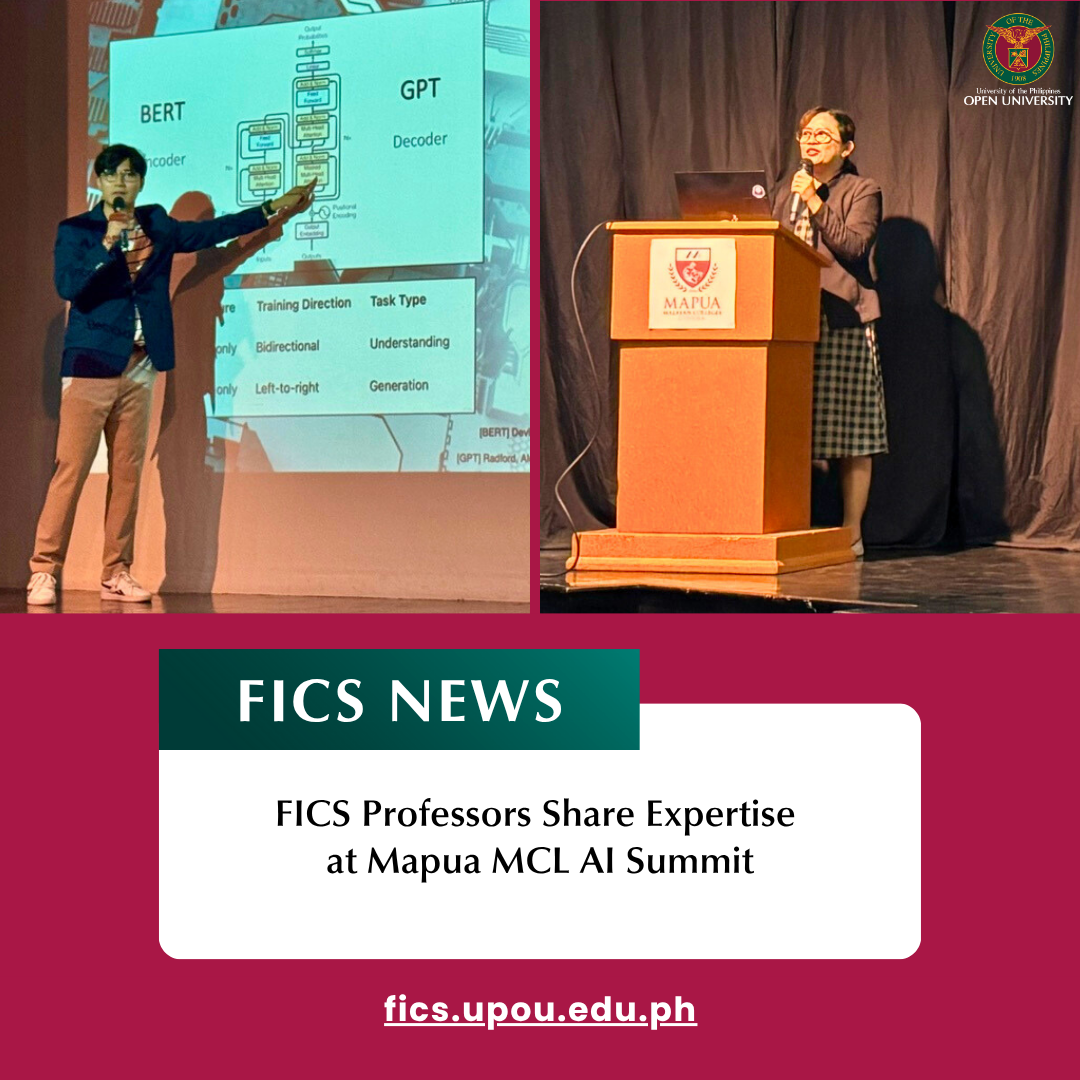Associate Professor Reinald Adrian Pugoy and Assistant Professor Blancaflor Arada from the Faculty of Information and Communication Studies (FICS), University of the Philippines Open University (UPOU), served as resource speakers during the AI Summit organized by the College of Computer and Information Science (CCIS) of Mapua Malayan Colleges Laguna (MMCL) on 11 June 2025. The summit, titled “Redefining Intelligence: What It Means to Be Human in an AI World,” was held as part of the institution’s CCIS Month 2025 celebration, which carried the theme “Celebrating Computational Innovations and Sustainability.”

Dr. Pugoy (in blue coat) poses with the MCL AI Summit organizers after his talk.
Associate Professor Pugoy delivered a presentation on “The NLP Revolution: The Journey from Symbolic Rules to Large Language Models,” which provided an overview of key developments in natural language processing and discussed their implications for the future of artificial intelligence. In his talk, Dr. Pugoy traced the significant milestones in the development of Natural Language Processing (NLP)—a core area in artificial intelligence that enables machines to understand and generate human language. His presentation outlined the evolution of NLP from early symbolic rule-based systems, which relied on manually crafted grammar rules, to the current era of large language models (LLMs) like BERT and GPT.
Dr. Pugoy discussed how statistical methods in the 1990s began replacing rigid rules with probabilistic models, enabling more flexible and scalable language processing. This eventually gave way to the deep learning revolution, introducing neural networks and techniques like word embeddings, RNNs, and LSTMs that significantly improved machine comprehension.
The most transformative leap, according to Dr. Pugoy, came with transformer-based architectures—the foundation for today’s LLMs. These models have unlocked new possibilities in machine translation, conversational AI, content generation, and more, reshaping how humans interact with digital technologies.
Assistant Professor Arada gave a talk titled “The Rise of AI-Generated Anime: Tools, Trends, and Implications,” where she explores the evolution of Japanese anime and the transformative role of artificial intelligence in its production. It outlines how anime’s distinct facial features—such as large eyes and stylized hair—define the genre, then traces anime’s development from early Western influences and wartime propaganda to post-war innovations led by Osamu Tezuka, the genre explosion of the 1970s–1980s, and the global recognition it achieved through films like Akira and Studio Ghibli’s works.
In the modern era, digital technologies and streaming platforms have propelled anime’s global reach and diversity. The presentation then delved into how AI tools like StyleGAN2, AnimeGAN, and diffusion models convert human portraits into anime-style images using facial detection, style transfer, and neural networks.
While AI increases production efficiency and opens creative possibilities, it also poses challenges such as copyright issues, workforce displacement, and concerns over artistic authenticity. Looking ahead, the integration of AI is expected to lead to hybrid production models, empower independent creators, and enable new interactive and personalized anime experiences, all while raising important ethical and legal considerations.
Together, the talks by Associate Professor Pugoy and Assistant Professor Arada gave an insightful and engaging look at how AI is changing the way we understand language and create visual art. From the rise of large language models to the use of AI in anime production, both speakers showed how technology is shaping the future in exciting—and sometimes challenging—ways. They also reminded the audience that while AI brings new opportunities, it’s just as important to think carefully about the ethical and social issues that come with it. In the end, their presentations called for continued learning, open dialogue, and thoughtful innovation as we move forward in this AI-driven world.

